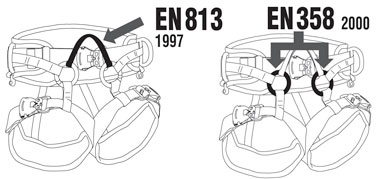The Treemotion harness has many features that other harness manufacturers like to copy (if possible). One such feature is the use of the lower D-rings for work positioning lanyard attachment.
Who cares about lower D attachment, you might ask? Well, here's a quick suspension test you can do.
Imagine you are in a work position where you need to have a lanyard above your head (say an overhead branch). Throw your lanyard over the branch, attach it to the side D's, and sit in the harness. Ouch!
The Treemotion lower D attachment points are certified to EN 813. This means the Treemotion harness is designed to easily accommodate the more deficient D 'sit' test - the lower connection points are fully rated for use in a 'sitting' work position.
But the same cannot be said of all harnesses.
Petzl Sequoia owners have a slight dilemma if they try the Treemotion 'sit' test.
The Sequoia 'gated rings' are certified to EN 358; as such, they can be used for lanyard attachment but only when the lanyard forms a metaphorical extension from the climber's waist belt, attached more or less horizontally at waist height.
In other words, for tree work, the 'gated rings' on the Sequoia harness are certified for use when the lanyard is thrown around a stem at about waist height, e.g. when using climbers. See 7B in the Sequoia Data Sheet.
To complete the Treemotion 'sit' test, the Sequoia gated rings must be certified to EN 813 (for suspension).
Effectively, the EN 358 'gated rings' can be only used as a lanyard connection point in some tree climbing maneuvers but not others.
The Treemotion is the only harness Treetiools is aware of with suspension-certified EN 813, lower D attachment points. The lower D attachment points on some other harnesses 'comply', 'conform', or are 'tested to' the EN 813 standard, but they are not fully certified.

